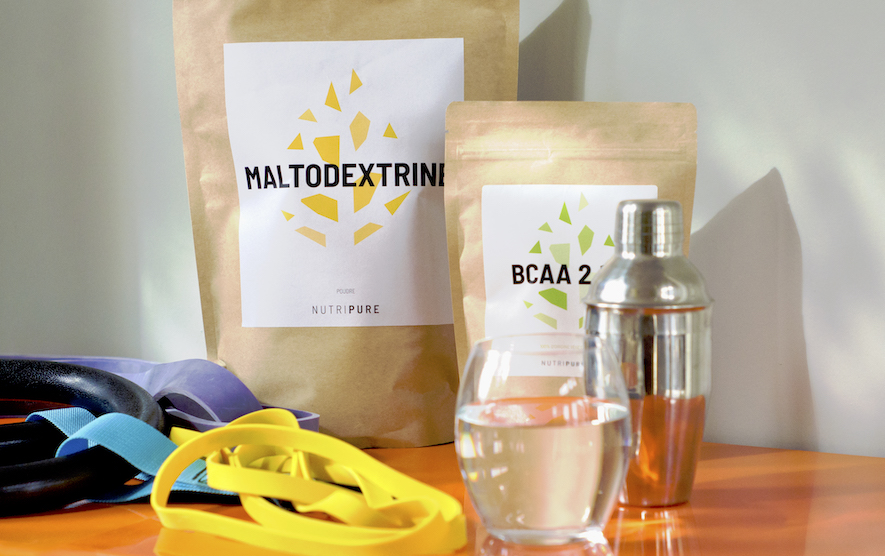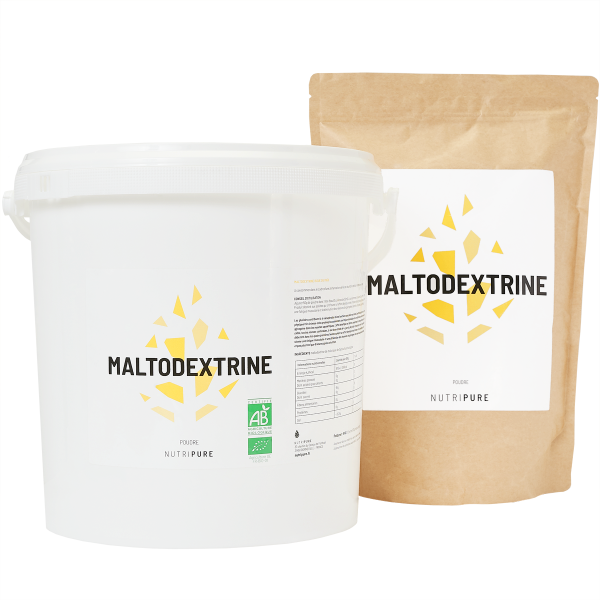nutrition is a key factor in high level athletic performance and in particular the intake and quality of carbohydrates. They are presented as the fuel of the athlete. But between maltodextrin, glucose, fructose, dextrose, … which carbohydrate is it better to consume to replenish the stock of glycogen in the event of endurance and bodybuilding?

The interest of maltodextrin
Physiological needs during exercise
In athletes, energy needs increase with the expenditure induced by exercise . Therefore, the carbohydrate intake should be higher and represent around 55 to 60% of the calories consumed. But carbohydrate needs vary depending on gender, age, type of activity, frequency and intensity of training.
In practice, the athlete uses up to 1 to 1.2 g / min of carbohydrates provided by the diet, or 60 to 70 g / h for a man of 70 kg.
To support the effort, our body draws on the energy reserves at its disposal. Although lipids (our fat reserves) are also a source of energy, the body prioritizes the use of carbohydrates for immediate energy production and during intense effort. Thus, it first consumes its carbohydrate reserves in the form of muscle glycogen.
In fact, glycogen makes it possible to supply glucose very quickly to the organs under stress, passing through the bloodstream.
Unfortunately glycogen reserves are not expandable. For intense and / or fractional type efforts (running, trail running, cycling, combat sport, ball or ball sport, bodybuilding) coverage of carbohydrate needs is essential. Indeed it will allow
- to avoid a drop in performance during exercise
- to speed up recovery
- to avoid a decrease in the activity of the immune system
- to avoid disturbances of the intestinal mucosa which needs to stay a minimum hydrated during an effort and which needs a minimum of carbohydrates to maintain its tightness.
That’s why we recommend maltodextrin carbohydrates with water during your intense workouts.

Organic maltodextrin
- check 100% pure ORGANIC maltodextrin – High GI carbohydrates: 95 – Equivalent Dextrose Index: 19
- check Complex sugar to replenish muscle glycogen reserves
- check Long effort: take Maltodextrin for 2 to 3 days before exercise and during exercise
- check Intense effort: mix 50g of Maltodextrin in 800ml of water and drink during exercise
- check Neutral taste – No sweeteners or sweeteners
The use of maltodextrin for bodybuilding
Maltodextrin is very popular with athletes today. Many athletes use it to help improve their athletic performance and results. It constitutes a supply of complex carbohydrates with rapid assimilation.
Diluting pure maltodextrin in water makes it possible to prepare energy drinks with low osmolarity (measurement of the concentration of a solution) in relation to the amount of carbohydrate provided. The drinks are thus isotonic, without a pronounced sweet taste, and promote rehydration. It is therefore ideal for training or recovery.
Maltodextrin, in bodybuilding, helps meet the needs for immediate muscular effort. This sugar therefore helps to replenish muscle glycogen reserves. At the end of a weight training session or following a competition, carbohydrate reserves are less emptied and recovery is faster.
The amount to consume during a weight training session depends on the effort required. For example, for a session lasting from 1 hour to 1 hour 30 minutes, the dose to take is 50 g of Nutripure maltodextrin powder to be diluted in 500 to 800 ml of water and then consumed in small sips. For more efficiency, maltodextrin can also be combined with BCAA .

The use of maltodextrin for long efforts
High intensity or prolonged workouts put a strain on the body. They cause muscle fatigue and decrease glycogen stores in skeletal muscles.
However, our muscles can store on average 1 to 10 g / kg of muscle for a total on average of 400 g of glycogen. As a result, glycogen reserves quickly become a limiting factor during long events such as trail running. During exercise, it is essential to provide regular carbohydrate intake before, during and after endurance exercise, in order to slow the decline in reserves and limit their depletion.
Therefore, in very intensive or long-term exercise, exercise drinks are essential to improve the maintenance of activity and protect the intestinal mucosa of the athlete as well as his immunity .
Thanks to its high glycemic index, maltodextrin promotes the recharging of energy reserves in the form of glycogen necessary for long-term efforts. Thus, maltodextrin during exercise is particularly appreciated by athletes because it contributes to the recovery of normal muscle function .
Maltodextrin, what is it?
a. The manufacture of maltodextrin
Maltodextrins belong to the carbohydrate family. Their calorie intake is 4 kcal / g. Unlike dextrose, sucrose or even fructose which are simple carbohydrates, maltodextrin is a complex carbohydrate (see definition later in the article). It is obtained through the hydrolysis of starch from cereals such as wheat, corn, or potato or tapioca starch. The hydrolysis process involves cutting long chains of carbohydrates into shorter chains that may contain different sugars such as glucose, maltose, or other complex sugars.
However, this process can be stopped at different levels giving rise to different forms of maltodextrins. They are defined by the degree of hydrolysis expressed in D.E. or Dextrose Equivalent. In fact, the greater the hydrolysis, the higher the D.E. and the higher the proportion of simple sugars in maltodextrin.
Some benchmarks:
- DE = 100 corresponds to a glucose or a fully hydrolyzed starch such as pure glucose or that of dextrose
- DE = 0 concerns unprocessed starches
- 0
- DE> 20 corresponds to glucose syrup
b. What is the composition of an organic maltodextrin?
Just like standard or so-called conventional maltodextrin, organic maltodextrin is made from grains. However, corn or wheat crops are certified organic. Therefore, it does not contain GMOs and the use of pesticides is reduced and only of plant, animal, microbial or mineral origin according to Regulation (EC) No. 889/2008 of the European Commission. An organic maltodextrin is obtained by a simple enzymatic hydrolysis in order to preserve the nutritional qualities of the food from which it is derived.
By selecting an organic source, athletes better protect their body and the environment with an equivalent level of performance.
c. Should we prefer a maltodextrin from maize or cassava?
These 2 forms of maltodextrins are differentiated by their DE. The ED of maize maltodextrin is equivalent to 19 while that of cassava maltodextrin is 10. Therefore, maize maltodextrin provides more simple short-chain sugars and causes a higher amplitude of the blood sugar peak. This source of malt is then more suitable for endurance sports to provide immediate energy.
However, maltodextrin from cassava can also be used by endurance athletes since the ED values of maize vs cassava remain fairly close.
d. Is maltodextrin vegan and gluten free?
Vegan maltodextrin? This carbohydrate is ideal for people who follow restrictive diets. It is perfectly suited to a vegetarian or vegan diet. In fact, maltodextrin comes from cereals and therefore from plant sources. In addition, the production process does not use material of animal origin. Thus, vegan athletes can consume this carbohydrate to optimize their performance in all serenity.
Gluten-free maltodextrin? All maltodextrins are gluten-free, whether they come from corn or wheat as confirmed by European regulation n ° 1169/2011 (INCO regulation). However, NUTRIPURE has chosen corn as a source of maltodextrin since this cereal is naturally gluten-free. It is therefore considered safe for people with celiac disease or gluten intolerant athletes.
Maltodextrin or dextrose?
What is the best carbohydrate for bodybuilding athletes? recommended for athletes genotropin preis In fact, these two carbohydrates have a high glycemic index. They help replenish the body with glycogen after a workout.
However, maltodextrin is a complex carbohydrate unlike dextrose which is a simple sugar. It has an ED between 0 and 20 while the ED of dextrose is 100.
Its ingestion therefore more easily causes an increase in the level of insulin in the blood. It is therefore preferable to choose maltodextrin.

Organic maltodextrin
- check 100% pure ORGANIC maltodextrin – High GI carbohydrates: 95 – Equivalent Dextrose Index: 19
- check Complex sugar to replenish muscle glycogen reserves
- check Long effort: take Maltodextrin for 2 to 3 days before exercise and during exercise
- check Intense effort: mix 50g of Maltodextrin in 800ml of water and drink during exercise
- check Neutral taste – No sweeteners or sweeteners
See the product
Is corn maltodextrin a low or high Glycemic Index carbohydrate?
a. What do you call a quick sugar?
There are different types of carbohydrates:
- Simple carbohydrates also known as fast sugars such as glucose, fructose or sucrose which are found in fruits, honey or just sugar. Sweet in flavor, they contain one or two molecules of glucose.
- Complex carbohydrates or slow sugars such as starch or cellulose contained in starchy foods (pasta, cereals, legumes, rice, etc.). They are made up of hundreds of glucose molecules and do not have a sweet taste.
These two categories of carbohydrates differ in particular by their glycemic index.
Definition of the glycemic index
The glycemic index or glycemic index (GI) is an indicator of the ability of a food to increase blood sugar levels, namely the level of glucose in the blood . It defines the hyperglycemic power of a substance in comparison to that of a reference sugar such as glucose which is 100.
So if a food has a GI of 60, for example, it means that the increase in blood sugar caused by ingesting that food is 60% of that obtained with glucose.
We are talking about low GI for foods with a GI 70. Between the two, we are talking about moderate GI.
In other words, the higher the GI of a food, the higher the blood sugar levels of the food consumed. The pancreas then secretes insulin according to the blood sugar level allowing to regulate the blood glucose concentration to a normal level. This is why the GI is often associated with hygiene and dietetic rules in cases of diabetes but also obesity because excess sugars in the blood are stored in the body in the form of fats.
We are also talking more and more today about glycemic load which provides information on the quality of carbohydrates in food. More precisely, this indicator takes into account both the GI but also the amount of carbohydrates ingested.
Our opinion on maltodextrin
Maltodextrin is not a slow sugar, but a fast absorbing complex sugar. All maltodextrins have a high GI of 95 but its quality differs depending on the type, the DE but also the conventional or BIO quality.
Our Maltodextrin Nutripure has an DE of 19 composed of several sugars: 94% higher polysaccharides, 5% disaccharides and 1% glucose. What’s more, it is certified organic.
It helps restore carbohydrates which are easily digested and assimilated by the body. Maltodextrins are considered a good source of energy for athletes because they are easily absorbed by the body.
Maltodextrin comes as a white powder with no sweet taste and is odorless. In addition, it is easy to use thanks to its good solubility in water. It is therefore ideal for the preparation of energy drinks .
Maltodextrin also has low osmolarity. It makes it possible to prepare isotonic drinks facilitating their absorption and making the carbohydrate intake as efficient as possible. It facilitates the regulation of digestive osmolarity which is altered in the event of intestinal disorders. In other words, maltodextrins are more effective for hydrating athletes
